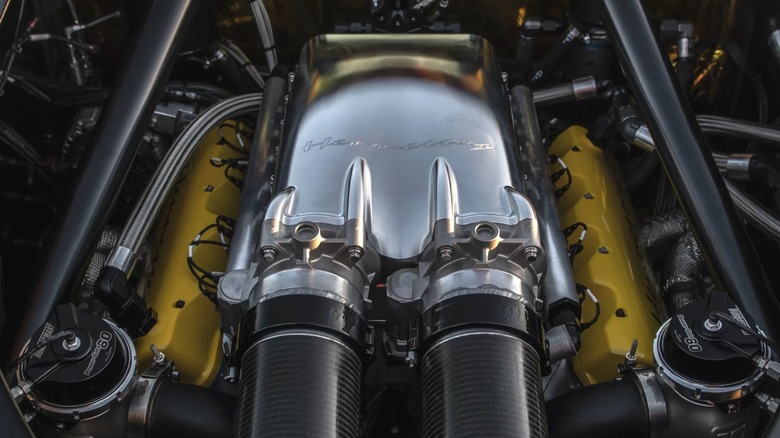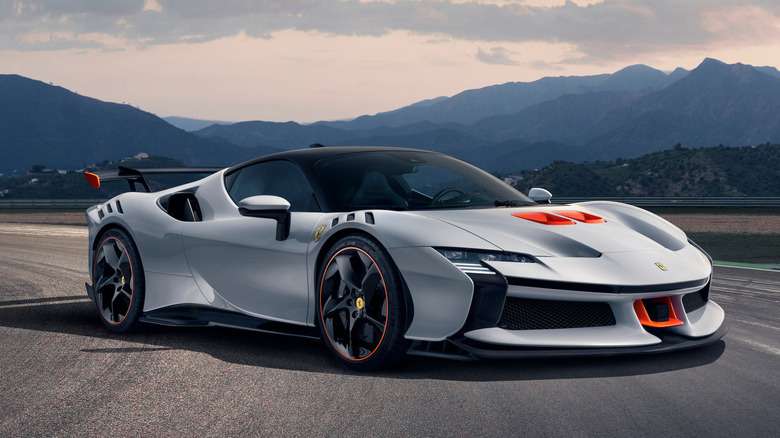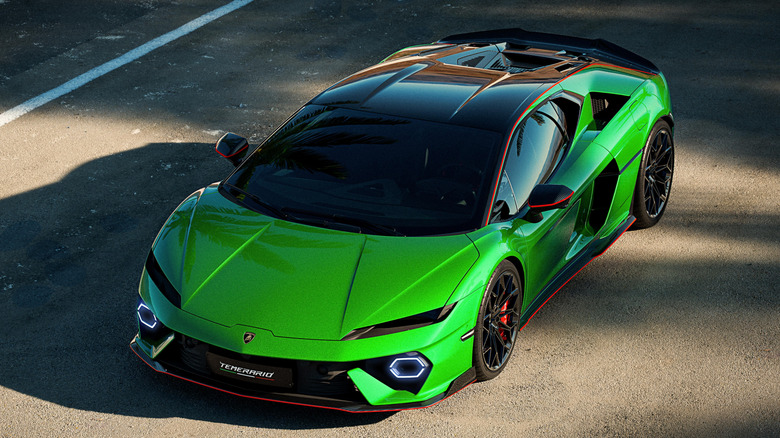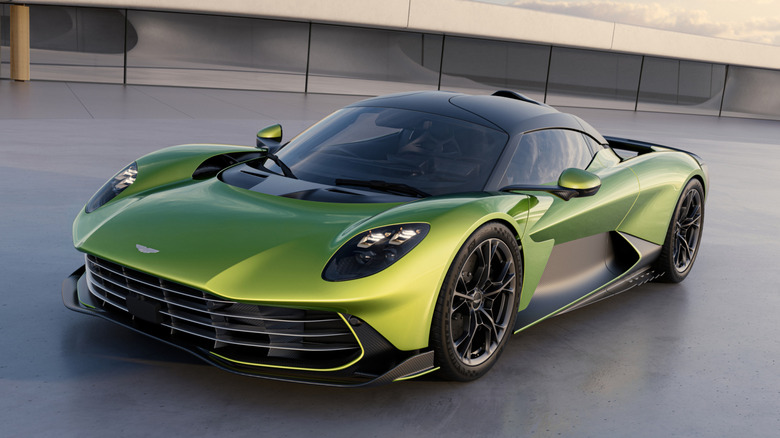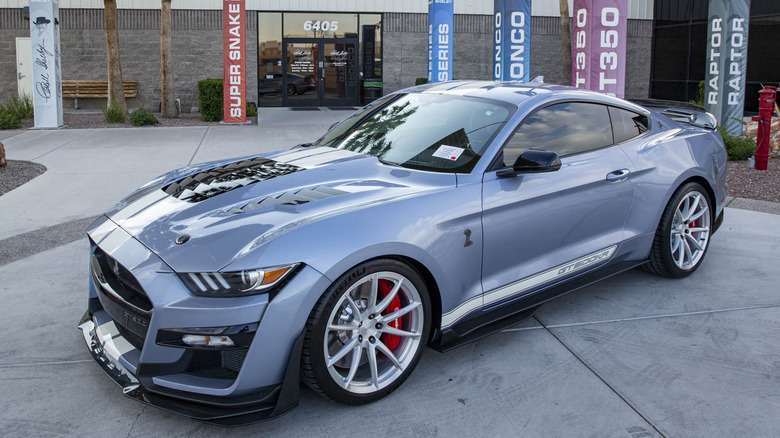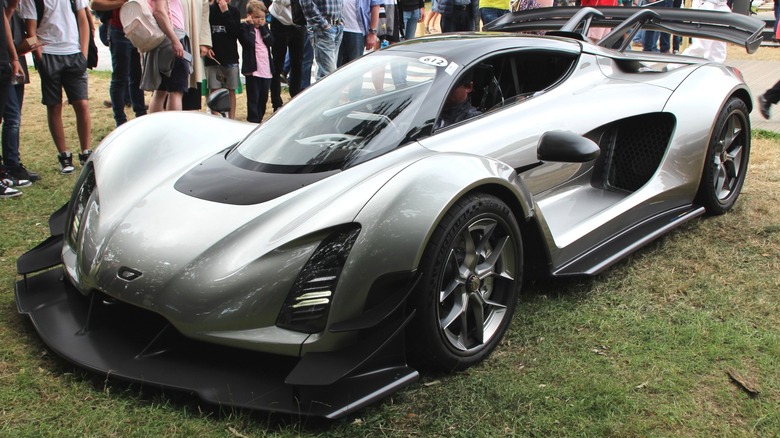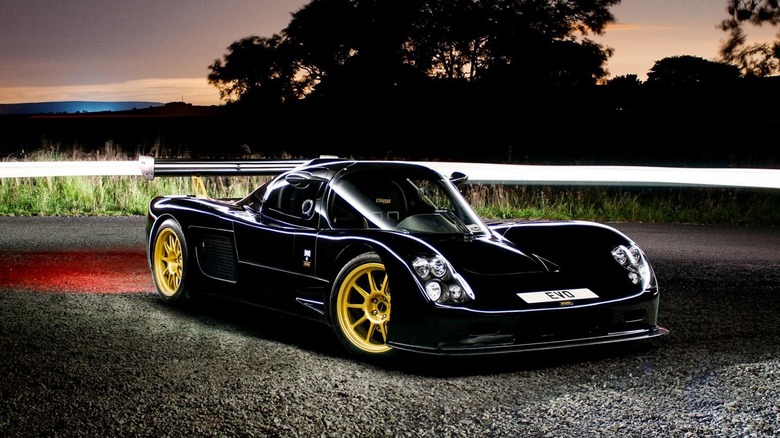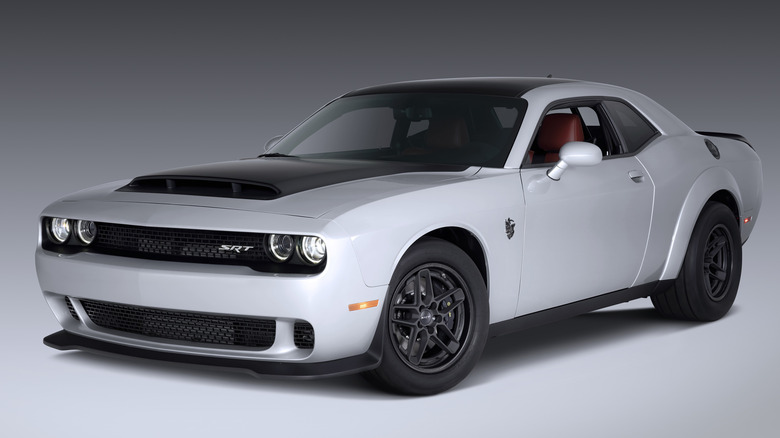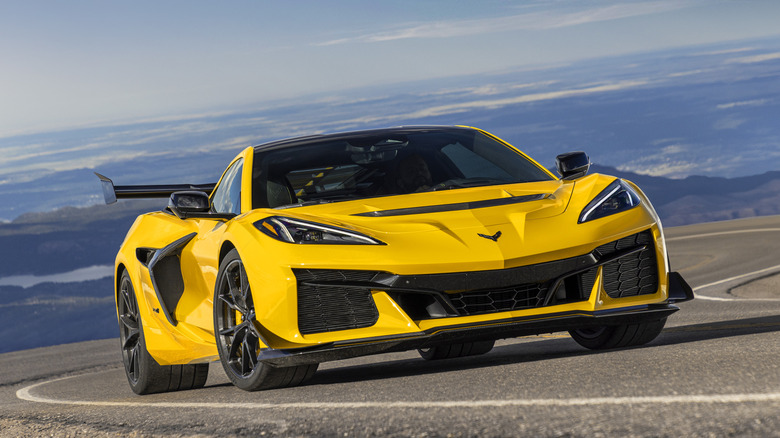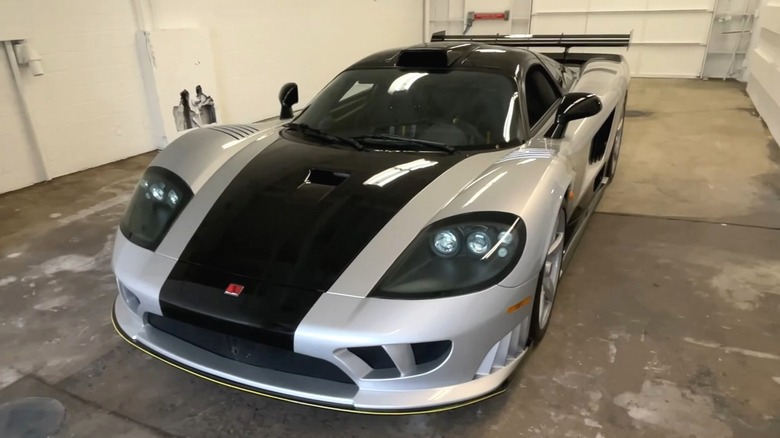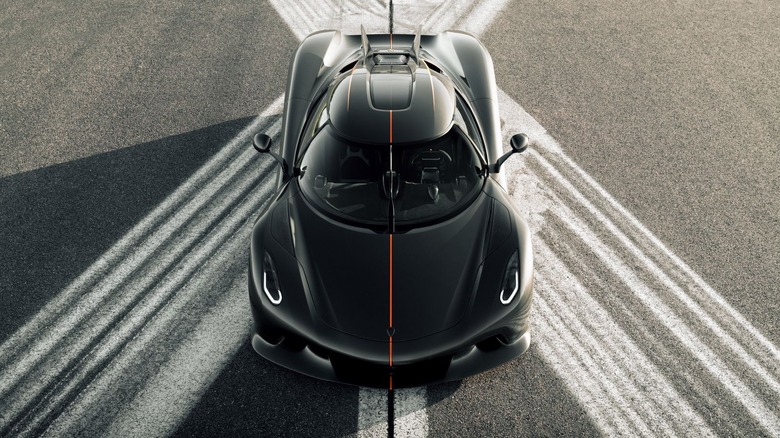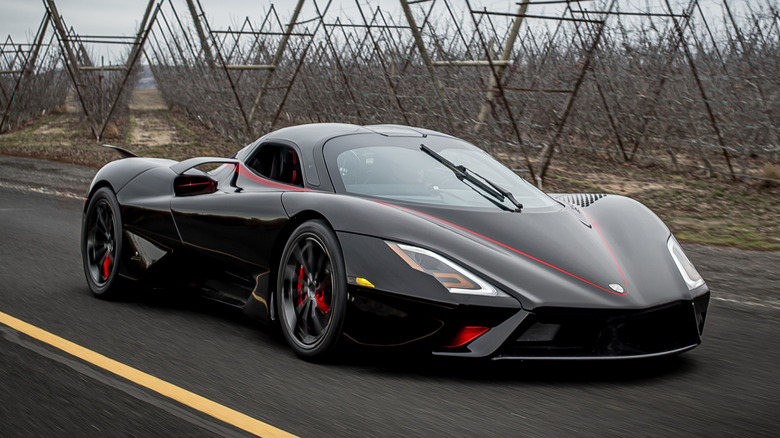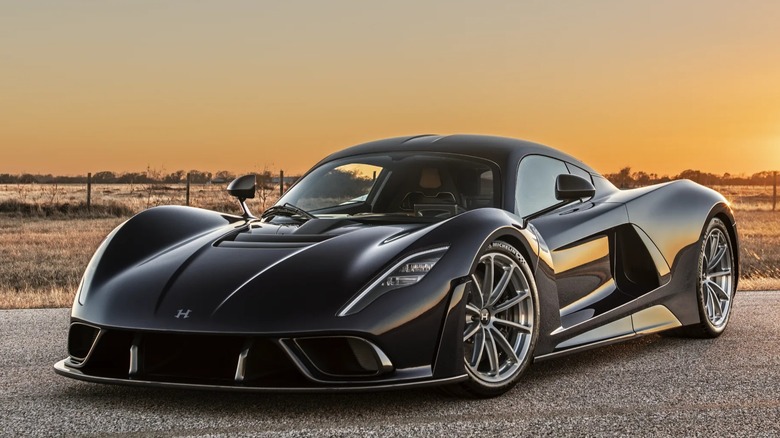12 Of The Most Powerful V8 Engines, Ranked By Horsepower
It's probably safe to say that the V8 landscape isn't quite what it used to be. Whether it's Dodge discontinuing the Hemi, Mercedes-AMG dropping V8s from its C63 and E63 cars, or Toyota axing the Land Cruiser 70's V8 turbo-diesel, the past few years haven't held much good news for fans of eight-cylinder goodness.
The situation isn't all bad, though: Ford is sticking to its V8 guns with the Mustang, and even Lamborghini is getting in on the action with a brand-new V8 in its Temerario. But even then, the situation isn't quite what it used to be: the Temerario has three electric motors bolstering the V8's power output, and it's far from the only high-performance V8 car to do so. So, while the V8 isn't gone yet, we may just be seeing a slow shift in the kind of experience V8 cars will offer going forward.
Let's not fret too much for now. Instead, why not celebrate the beauty of the V8 in all its glory, electrified or otherwise? Here are 12 of the most powerful V8s to ever hit the streets, ranging from relatively mundane 700-plus hp engines up to those producing north of 1,500 hp. And, just for a bit of variety, we've opted to go with 12 different carmakers as well.
Ferrari F154 — 786 hp
We start out in sunny Italy with an engine from one of the most iconic carmakers in the world, the Ferrari F154 V8. One of the more long-lived engines on this list, the F154 V8 debuted in 2013 and has seen action in quite a few Ferraris over the years. It debuted as a 3.8-liter, 552-hp power plant in the 2016 Ferrari California T and, most recently, occupies the engine bay of the hybrid SF90 Stradale, in 4.0-liter 769-hp guise.
But even that wasn't enough for Ferrari: The Italian automaker launched even hotter versions of the SF90 Stradale in 2023, the Ferrari SF90 XX Stradale and Spider, both of which featured a more powerful version of the F154 V8. These ultra-exclusive hypercars crank the V8's power up to 786 hp and 593 lb-ft of torque, thanks to improvements like new pistons, more compression, and a new combustion chamber. The electric motors also get a new logic that allows the driver to trigger a temporary boost to the electric motors in the car's Qualifying mode, offering 229 hp up to 30 times per session.
All the improvements combine for an estimated 0-60 mph time of 1.9 seconds and a lap time around Ferrari's Fiorano test circuit of 1:17.3, beating the previous production car record by 1.7 seconds on a 1.9-mile track. Quite a feat.
Lamborghini Temerario V8 — 789 hp
Now we turn to Ferrari's long-time Italian rival, Lamborghini. The Italian marque may be best known for making some of the best V10-powered cars ever and for flying the V10 flag longer than others, but even it had to give the V10 up eventually. Not that Lamborghini's gone soft, mind you, as the V8 in its Temerario proves.
Lamborghini's Temerario, which the company unveiled at 2024's Monterey Car Week, sports an all-new electrified V8 engine, with its 4.0-liter twin-turbos complemented by three electric motors — one between the engine and transmission, and two on each front wheel. Lamborghini claimed that it dropped the V10 because the engine couldn't meet the carmaker's power goals , and the Temerario shows that the decision may have been the right one. The V8 alone makes 789 hp and 538 lb-ft of torque, more than even the Huracán Sterrato, while the total power output including the motors is an impressive 907 hp — good for a 0-60 mph time of 2.7 seconds.
How did Lamborghini get that much power out of a 4.0-liter V8? Turbos help, of course, as does cranking the boost up to 36 psi. The V8 also revs to 10,000 RPM, thanks to a flat-plane crankshaft.
Mercedes-AMG M178 LS2 — 816 hp
We stay in Europe for a little longer for the third engine on our list: Mercedes-AMG's M178 LS2. Don't be fooled by the LS2 name, though — this has nothing to do with GM's second-generation LS engine. The LS2 here indicates it's a modified version of the original 4.0-liter M178 that powered the 2014 Mercedes-AMG GT.
The major difference with the LS2 is its use of a flat-plane crankshaft instead of the common cross-plane crankshaft. This essentially makes the M178 LS2 and other flat-plane V8s run like two four-cylinder engines, which improves exhaust gas flow and reduces weight. Combined with new turbos, increased boost, and tweaked compression, Mercedes-AMG managed to eke out 720 hp and 590 lb-ft of torque from the engine when it debuted in the 2020 Mercedes-AMG GT Black — enough for Mercedes-AMG to claim the Nurburgring lap time record for a production car.
As impressive as that is, though, it wasn't enough for Aston Martin and its engineers. The British carmaker's long-delayed Valhalla also uses the M178 LS2 V8, but with a lot more power: A December 2024 press release claims 816 hp from the engine, although Aston Martin hasn't revealed how it got that extra horsepower from the engine. We also don't know how much torque it makes, although it definitely accounts for a big chunk of Valhalla's total 1,064 hp and 811 lb-ft of torque.
Ford Mustang Shelby GT500KR V8 — 900 hp
Three European V8s in a row is enough; it's time for some good old-fashioned American muscle. And what better starting point than Shelby's most potent take on the sixth-generation Ford Mustang, the ultra-limited-edition Ford Mustang Shelby GT500KR?
The GT500KR was the pinnacle of Shelby's sixth-generation efforts, surpassing even the GT500 and its 760 hp, 625 lb-ft 5.2-liter V8 engine. For the GT500KR, Shelby engineers dropped a larger 3.8-liter supercharger onto that same engine and, coupled with a cold-air intake, beefier intercooler, and upgraded heat exchanger, managed to extract more than 900 hp from it with 93-octane fuel. Sadly, Shelby never revealed exactly how much more, nor did it disclose official torque numbers.
Not that power was the 2022 GT500KR's only selling point, mind you. Shelby also installed adjustable front and rear springs, new sway bars, recalibrated the MagneRide suspension, and specced new rubber for the fancy forged aluminum wheels. Shelby only built 225 examples of the GT500KR, but its spirit lives on in the 2024 Shelby Super Snake Mustang, which puts out more than 830 hp.
Czinger 21C V8 — 950 hp
The V8 in Czinger's 21C might not be the most powerful one on this list, but it's possibly our favorite. At just 2.9 liters, it the smallest engine here — it makes even the relatively pedestrian 4.0 liters of the Mercedes, Ferrari, and Lamborghini engines seem humungous in comparison. It also revs to the moon, or less hyperbolically, to 11,000 RPM. In that sense, it's the inverse of the stereotypical American V8 with its huge displacement and generally lazy power delivery.
Admirably for a small upstart manufacturer, Czinger developed the 21C's V8 in-house, relying on a flat-plane crankshaft and twin turbos to be able to produce those impressive headline figures. As is fast becoming the case with many supercars, Czinger complements the V8 with three electric motors, the total combination good for 1,250 hp — with the option of increasing it to 1,350 hp — and a 0-60 mph time of 1.9 seconds.
It's also great in the corners, thanks to the ultra-sticky Michelin Pilot Sport Cup 2R tires and the 5,512 pounds of downforce its racecar-style body makes. That body isn't just an aerodynamic and aesthetic marvel, either: Czinger 3D-prints the body via its proprietary divergent adaptive production system (DAPS), with a healthy pinch of AI smarts helping the process on its way.
Ultima Evo supercharged LS — 1,020 hp
Ultima is far from a household name, but the tiny British automaker has been making insanely high-powered cars for a while, the most recognizable of which (at least if you're a "Forza Horizon" player) is very likely the Ultima Evo which, in its most powerful form, plays host to a 1,020 hp supercharged LS engine.
Ultima has remained coy about what it did to get that much power out of the LS (beyond the supercharger, of course), but that doesn't matter all that much. What matters is that the Evo is incredibly rapid, with 0-60 mph and 0-100 mph times of 2.3 and 4.9 seconds, respectively. That's not just down to the power, either: The 1,000-hp LS sits in an incredibly light fiberglass body and tubular steel frame, with the total weight coming out a shade under 2,100 pounds fully wet. That means the milder 700 and 480-hp versions are also very quick, with even the 480-hp version hitting 60 mph in just 3.1 seconds.
And while the Ultima is far removed from any of its LS-powered muscle car relatives, it does have a bit of the old-school muscle car spirit within it: The Evo is rear-wheel drive, has a manual gearbox, and has no driver aids whatsoever. Good fun or a recipe for disaster? That probably depends on how good you are behind the wheel.
Dodge Hellephant C170 — 1,025 hp
Chrysler's Hemi engines have a long and storied history, whether we're talking about the iconic 426 Street Hemi in cars like the Dodge Charger Daytona or the more modern Gen 2 and Gen 3 Hemis. But while there have been plenty of great Hemis over the years, it's hard to deny that the Hellephant C170 is one of the all-time greats — at least as far as raw horsepower goes.
The Hellephant C170 is the crate version of the 1,025-hp engine in the 2023 Dodge Challenger SRT Demon 170, one the many "Last Call" models it released to celebrate the final year of the Hemi. The Demon's crazy horsepower output came with an impressive 945 lb-ft of torque, and that's also what owners of the Hellephant will get, provided they fuel up with E85. That said, it's still a mind-bendingly powerful engine on pump gas, with 900 hp and 810 lb-ft of torque on tap with the more mundane fuel.
Yes, the C170 makes more power on pump gas than the Hellcrate Redeye 6.2-liter, which tops out at 807 hp. All that extra power comes from various upgrades, including a 3.0-liter IHI supercharger, upgraded cylinder heads, better pistons, tougher connecting rods, a larger throttle body, and more durable materials. The catch? A price of just under $30,000, naturally.
Chevrolet LT7 — 1,064 hp
GM is no stranger to high-powered V8s, but the LT7 in the new Chevrolet Corvette ZR1 is a special one, even by the standards of other LS and LT engines prior. It may carry the LT family name, but the LT7 is quite far removed from your traditional Chevy small block, retaining the classic 4.4-inch bore spacing but bringing a whole host of new tricks and tech to the table.
For one, the LT7 has a flat-plane crankshaft like a few other engines on this list, although it doesn't rev nearly as high: The LT7 tops out at around 8,600 rpm, quite a ways behind the Lamborghini and Czinger flat-plane V8s. However, it beats both in terms of raw power, with its 1,064-hp, 828 lb-ft output making it the most powerful flat-plane V8 we've seen so far. That immense power output comes thanks to twin turbos, which ram air into the 5.5-liter engine at an impressive 24 psi at maximum boost. GM engineers went to town with the other components, too, with a unique intake system, heavy-duty internals, and some serious fuel injection amongst the many changes from GM's other V8s.
All this power helped Chevrolet reach a record-breaking 233 mph during a top-speed run in 2024, good enough to make the ZR1 the "fastest car ever built by an American auto manufacturer," according to GM. SSC and Hennessey may have something to say about that, though.
Saleen S7 LM V8 — 1,500 hp
If you've heard of Saleen in recent years, it's likely involved the troubled Chinese joint venture and alleged sham partnership founder Steve Saleen undertook in 2017. But modern troubles can't dull the luster of all the cars that have borne the name over the years, chief of which is the underappreciated Saleen S7 supercar.
The original S7 debuted back in 2000 with a 7.0-liter V8 — thus the name — that made 550 hp and 560 lb-ft of torque on paper, although it allegedly made much more than that. But we'll go with the official numbers since that's all we have to go by. Power soon climbed to 750 hp and 700 lb-ft of torque in the twin-turbo S7TT, which debuted in 2005 and lasted until Saleen ceased production of the S7 in 2009, with allegedly fewer than 100 S7s built over nine years. But that wasn't the end of the story: In 2017, Steve Saleen resurrected the S7 as the S7 LM, and this new S7 packed some major improvements in the engine department.
Saleen stuck with the same basics as the old S7 — 7.0 liters and twin turbos — but a raft of changes to areas such as the cylinder heads, turbos, and engine management resulted in a power output of 1,300 hp on standard pump gas and 1,500 hp on E85. Saleen planned to build just seven S7 LMs, each priced at $1 million, although the company allegedly only built three.
Koenigsegg Jesko Absolut V8 — 1,600 hp
It wouldn't be a list of high-powered engines (or cars) without a Koenigsegg somewhere in the mix. And that's what we have here: the Jesko Absolut and its V8, possibly one of the greatest achievements from Christian von Koenigsegg and his team of engineers, and most certainly the fastest Koenigsegg of them all.
Koenigsegg didn't reinvent the wheel when it came to powering the Jesko Absolut. The V8 is a twin-turbo, 5.0-liter powerplant like most other Koenigsegg cars, but where it stands apart is the flat-plane crankshaft, which Koenigsegg claims is the world's lightest at just 27.5 pounds. Paired with lightweight connecting rods and pistons, the engine allegedly manages to reduce the vibrations that tend to characterize flat-plane V8s. This all comes together to produce an impressive 1,280 hp on pump gas, climbing to 1,600 hp and 1,106 lb-ft of torque on E85.
The carmaker estimates that the engine, coupled with the Jesko Absolut's low 0.278-cd drag coefficient, should allow the hypercar to reach a top speed in excess of 311 mph, although nobody's managed that quite yet. The Jesko did manage to hit 250 mph from a standing start in 19.2 seconds, though, so a 300-plus-mph run is probably a matter of time.
SSC Tuatara V8 — 1,750 hp
Back to the U.S. for the top two V8s on this list, both of which offer a significant leap over the Jesko V8. In second place is the 5.9-liter, twin-turbo V8 powering the SSC Tuatara, one of the fastest American-made cars ever. You may remember the Tuatara for a controversial top speed record attempt, but let's leave that for a moment.
Like many of the V8s here, the Tuatara's powerplant uses a flat-plane crankshaft with twin turbos capable of feeding up to 30 psi of boost into the engine, and compressed air cooled by two air-to-water intercoolers. Other notable aspects of the engine include a large-bore, short-stroke design. This keeps piston speeds low and, along with lightweight internals, allows the 5.9-liter V8 to rev up to 8,800 rpm. Combine it all and you get 1,750 hp and 984 lb-ft of torque on E85, with more regular 91-octane fuel producing a still-impressive 1,350 hp.
Now, back to that record attempt. SSC initially posted a top speed record of 316 mph, but had to take a second stab at the record after doubts surrounding the accuracy of the measurement equipment used in the record-setting run. It's a complicated story, but the outcome was that SSC decided to perform another record attempt to clear things up. The Tuatara managed 282.9 mph during that second run — not quite as crazy, but still very fast nonetheless.
Hennessey Fury — 1,817 hp
If there's a better name for a 1,800-hp V8 than "Fury," we certainly can't think of one. It's the result of a decades-long pursuit of insane power, trumping crazy offerings like the 1,204-hp Venom 1200 Mustang GT500 and the 270.49-mph Hennessey Venom GT, which held the production car top speed record for a few years until Bugatti wrested the title in 2019. And that title is precisely what Hennessey has in its sights with the 6.6-liter Fury and the car it powers, the Venom F5.
The Fury shares some basics with a GM LS, including the LS7's cylinder bore and a pushrod design, but calling the Fury a souped-up LS would be a grave disservice to the engine and what Hennessey's engineers have done. It has a shorter stroke, for one, pushing the redline to 8,200 RPM. It also has dry-sump lubrication, aluminum cylinder heads, a 10:1 compression ratio, and, of course, a couple of turbos. These turbos generate 23 psi of boost, resulting in 1,817 hp and 1,193 lb-ft of torque. It's quite an engine, as our Dave McQuilling learned during his first drive of a Venom F5 in 2024.
Hennessey has yet to reclaim the top speed record as of early 2025, but the signs are promising. A Hennessey test driver managed 221.92 mph in the half-mile, faster than the Rimac Nevera and Bugatti Chiron Super Sport. Will 2025 be the year Hennessey reclaims the top spot? Only time will tell.
